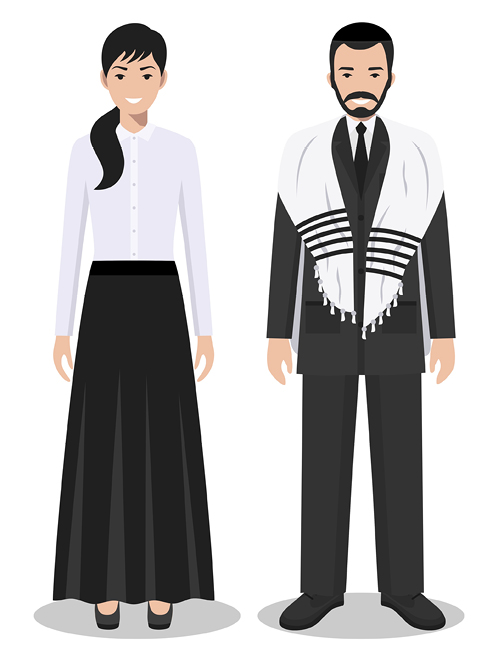Who Wears the Pants

They may not wear the archetypal pants in the family, but today’s Orthodox Jewish woman is generally self-possessed, driven, educated, and capable of making and managing her own choices. That she chooses to follow the Orthodox rabbinical mandate that women wear the skirts in the family – leaving the proverbial pants to the men – does not seem to be an indication of subservience – at least not to a husband.
The skirts only notion originates in the Torah (Old Testament) where it states, ‘A woman shall not wear that which pertains to a man...neither shall a man put on a woman’s garment’ (Deuteronomy 22:5). In other words, genders may not cross identify, even in fashion.
Yet the spectrum of thought and practice stemming from that creed is broad and complex.
“Not all Orthodox women are created alike,” says Hannah Katsman, a mother of six who blogs about her life and choices as an Orthodox Jewish American now living in Israel (www.amotherinisrael.com).
“We hail from diverse cultural, geographic, and ethnic backgrounds; varied experiences and traditions; and a wide range of rules,” Katsman says. “What unites us is our belief in G-d, behavior governing modesty, strict dietary (kosher) laws, Sabbath observance, devotion to family and community, and the laws pertaining to the spiritual relationship between spouses.”
Beyond those parameters, Katsman contends that observant women – like many other women – endeavor to make choices and assume roles according to their priorities, goals, interests, means, and shared objectives with a husband and family.
“Many religious women are politically and socially involved, own businesses, and contribute time, talent, and treasure to community and economy,” Katsman adds. “Most stay informed on local and national matters, along with caring for their families and working at self-improvement and personal growth.”
Wearing skirts, or the absence of pants, is no indication of submission or relinquishing rights says Judith Hauptman, a professor of Talmud and Rabbinics at the Jewish Theological Seminary in New York City.
“An important distinction is made in Judaism as between rights vs.
obligations,” says Hauptman. “Traditional Judaism looks at roles and behaviors through the lens of duties and obligations, rather than the modern socio-political characterization of rights,” she asserts. “Rights are inherent, or they ought to be. Duties and obligations are established to maintain the well-being of others. In traditional Judaism, men and women have different duties and obligations, each meant to enhance the other person. The question of rights never arises in the texts.”
According to Hauptman, one can argue that the laws tend to be more favorable toward women.
She cites the Ketubah, the Jewish marital contract between a man and a woman. Essentially, it states that the husband is ultimately responsible for his wife’s happiness and hence for Shalom Bayis, or peace in the home. The husband is bound to initiate the giving, especially when it comes to giving honor to his wife; and pleasing his wife sexually before he seeks pleasure for himself.
Additionally, according to the Talmud (the book of Jewish civil and ceremonial law) all the blessings a husband receives are in the merit of his wife. “There is no blessing in one’s home without the wife’s honor.”
Hauptman has not found a Jewish law – divine or rabbinic – that commands a woman to submit to her husband or a man to hold dominion over his wife. “I don’t even know women who would acquiesce to that!” she laughs. “If they did, I imagine it would be kicking and screaming the whole way!”
She adds that when both the man and the woman have rights and obligations, neither can be considered as mere property or owing submission to the other.
Modern Jewish marriage and Jewish law allows for couples to decide for themselves how they divide their responsibilities, childrearing, housework, decision-making, bread-winning, and observance of customs and traditions.
Sari Arshadnia is the regional director for American Friends of Rambam Medical Center in Los Angeles. She’s married and is an observant Jewish woman.
“My work requires me to travel” she says. “When I return home late, I can rely on my husband to have prepared dinner for us. That my husband is the one cooking that day – I don’t view it as a role reversal; nor have I abdicated my involvement in our domestic life. We’re flexible in the relationship and adapt as necessary to meet life’s challenges and opportunities.”.
Arshadnia believes that her marriage reflects much of what Judaism has to say about men and women. “We are fully equal but different – and we embrace that our differences are meant to complement each other,” she continues. “Through mutual respect and giving, our marriage contributes to our personal growth, creating a healthy foundation for a full-life, and the benefit of a broader life-perspective.”
That’s not to say that a Jewish woman cannot choose to be the CEO of her home and defer to a patriarchal relationship with her husband. “Jewish law does not regulate every detail of life. It provides a basic structure within which each person may express their own personality and lifestyle preference,” says Hauptman.
Torah philosophy, however, cautions that preoccupation with material pursuits ought to be secondary to higher religious activities such as family life, prayer, and charity; but this applies to men as well as to women.
Madelaine Brody values her life as an Orthodox woman, wife, and mother, but admits that she observes largely to please her husband, Martin. “It gives me great pleasure to make my husband happy. It’s important to him that we have a religious life and home and he’s grateful in turn that I’m willing to accommodate him. Making each other feel regarded and respected is what marriage is all about,” she says.
Martin, for his part, compares marriage to a chess game with the husband as king and the wife as queen. “And we all know what the queen can do,” he says with a wink and a nod.
